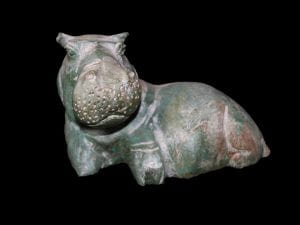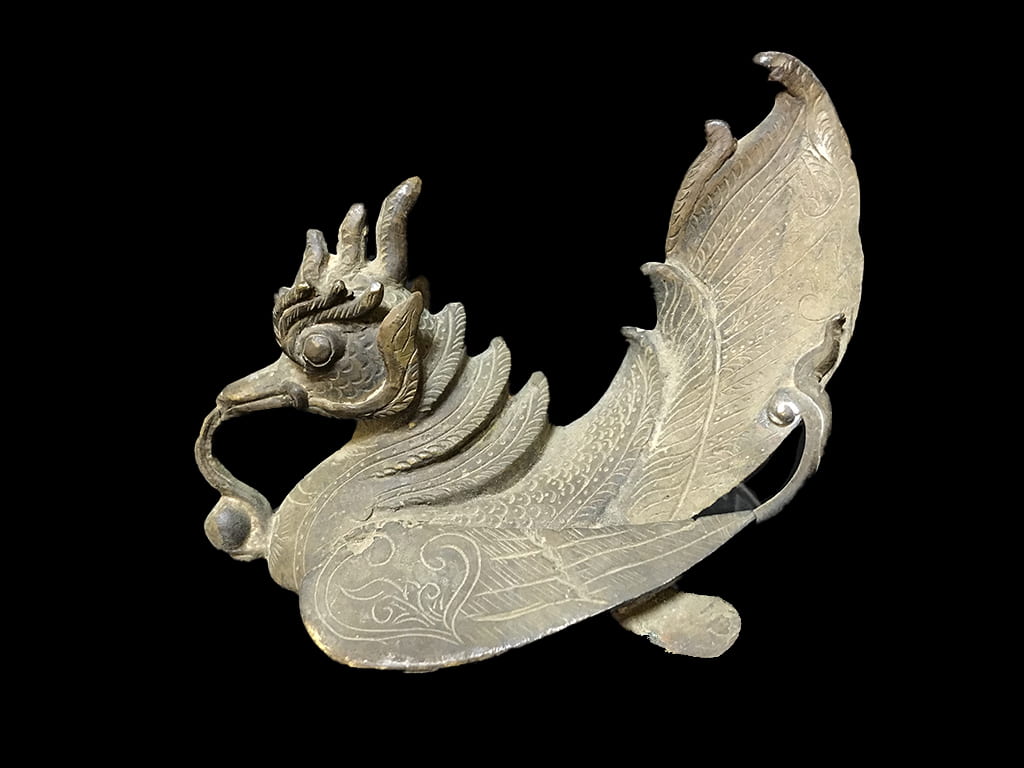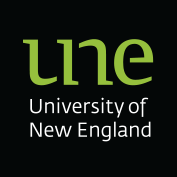Image: MA2020.3.15 Peacock Diya Lamp, Myanmar (Asia) donated to UNEMA by Bruce Reuman.
Long term supporter of the University of New England’s Museum of Antiquities (UNEMA), Bruce Reuman, passed away in April 2021. Bruce had been a patron of UNEMA for more than two decades and in early 2021, prior to his passing, Bruce made an incredibly generous donation of $200,000 to the museum. To commemorate his life and the invaluable support he provided to UNEMA, let us remember his story and his compassion.

• MA2020.3.151 Carved Stone Hippopotamus (Africa) donated by Bruce Reuman
Although Bruce’s support of the Museum of Antiquities began two decades ago, he has always had a generous nature. To get a true measure of Bruce it is important to know something of his background.
Bruce Reuman, born in 1945, lived in the New England of the United States before emigrating to the New England of Australia. He served in many roles, including as a member of the Peace Corps, as a staff member for an Ohio mental hospital, in the raising and selling of livestock, and for over thirty years as a teacher for TAFE, NSW.
Bruce’s curiosity took him around the world, where he took an interest in many causes, including scholarships for higher education students, and supporting community museums and cultural collections. Bruce was also an avid traveller and often sought to support local craftsmen, artists, and charitable institutions that were producing handicraft items for sale using traditional methods. This is how he came by many of the items that he would eventually donate to UNEMA.
His generosity towards the Museum began in 2001 when he gifted his collection of Guatemalan traditional costumes and Maya artefacts to UNEMA. This was followed in 2020 by the enormous gift of nearly two hundred ethnographic artefacts from Africa, Asia, the Americas, and Oriens.
Earlier this year, before passing away, Bruce donated $200,000 to the Museum – with the intention that it to be used to establish two permanent bequests, one to assist in increasing the artefacts in UNEMA’s ethnographic collections, and one to support the conservation of all artefacts in the collections of the Museum of Antiquities – both ethnographic (Africa, Americas, Asia, Europe, Oceania, and Oriens), and classical antiquities (Cyprus, Egypt, Greece, Italia, Near East and Rome). Curator of the Museum, Dr Bronwyn Hopwood, described Bruce’s generosity as having “ensured the integrity of UNEMA’s collections for the future.”
Bronwyn also described how vital donations like Bruce’s are for preserving and promoting the museum’s collections, and allowing UNEMA to focus on developing projects for teaching, research, and community engagement.
Bruce was not only a supporter of the Museum, but also of education and the opportunities that cultural collections can provide to all.
Bruce’s interest in preserving and celebrating cultures is an important aspect of his philanthropy. The story behind part of his 2001 donation illustrates this perfectly:

• MA2001.15.1 Silk Wedding Blouse from San Martin Jilotepeque, Guatemala (Americas) donated by Bruce Reuman in 2001
In 1988, while Bruce was serving with the Peace Corp in Guatemala, he observed the progressive changes occurring in the local villages, like the increasing purchase and use of synthetic threads, and even silk thread from India. In response, Bruce deliberately set out to purchase Guatemalan indigenous clothes (trajes indígenas) made using traditional weaving techniques and cloth. At that time, the clothing produced in each Guatemalan village still had its own distinctive shape, design, style, colours and patterns, which signalled where you came from and where you belonged. Bruce donated his collection to UNEMA in 2001.
While Bruce’s donations in 2001, 2020, and 2021 represent some of the largest that UNEMA has received, the Museum has received support from many generous donors over the years.
Those supporters include Alfred and Irene McCready, and their close friends Kwan and Pansy Lam, who established UNEMA’s fund for Egyptology; André Preibish, who named the UNEMA Leon and Anna Preibish Fund for Classical Antiquities in honour of his parents; the Charles Ede Prize, established by Jamie Ede, to support UNEMA’s student essay prize; and, the Maurice Kelly Lecture Fund, to help UNEMA host an annual public lecture. All of these donors have contributed substantial amounts of time, money, or artefacts to help make the museum what it is today, while countless others continue to make contributions.
Dr Hopwood, while reflecting on the importance of the Museum’s supporters, had thanks to share and further information for those thinking of donating:
“The Museum cannot thank its patrons and supporters enough. The wonderful collections and programs run by the museum are only possible because of our supporters. As the Curator of UNEMA, it has been such a privilege to see visitors get excited by the displays, to see students marvel at holding something 5,000 years old in their hands for the first time, and to see people of all backgrounds come to better understand others (or themselves) when they engage with our collections.”
“UNEMA can be supported in many ways, from gifts of artefacts, and the volunteering of time, to tax-deductible donations to UNEMA through the UNE Foundation (UNEF). All donations and support are very warmly welcomed and have been essential for sustaining the Museum’s teaching, research, and community outreach programs.”
“We also love to have people volunteer to work in the museum whether they are interested in researching the artefacts, helping with administration, or serving in a public engagement role.” More information about how to support UNEMA and to get involved is available on the UNEMA website and inquiries are always welcomed by UNEMA’s Curator, Dr Bronwyn Hopwood.



Recent Comments